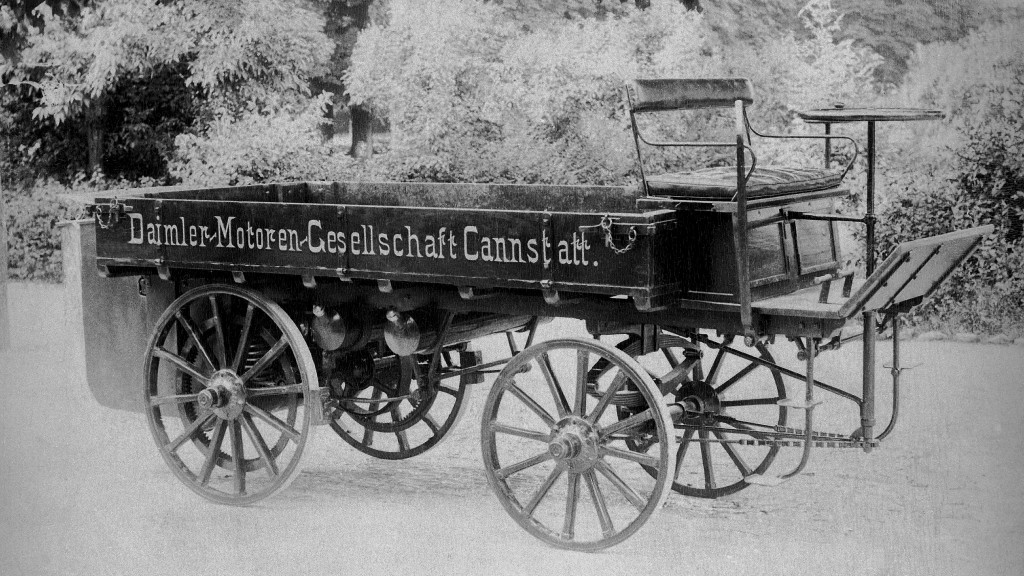
Gottlieb Daimler was a visionary inventor in the late 1800s. The inventor of multiple types of engine, Daimler used his technical knowledge to build a number of pieces of equipment - first the motorcycle, then a motorized trolley car, a motorized firefighting hose, and eventually to what, in 1896, was the world's first truck.
World's first truck looked like a cart with an engine
Pragmatism was behind the design of the first truck in the world, which looked like a cart with an engine and without a drawbar. The engine, called "Phoenix," was a four-horsepower two-cylinder engine located at the rear, with a displacement of 1.06 litres.
Daimler linked it to the rear axle by means of a belt. Two helical springs protected the engine, which was sensitive to vibrations - not unusual for a vehicle rolling on hard iron wheels.
Daimler steered the leaf-sprung front axle by means of a chain. The driver sat up front on the driving seat, as with a carriage. Fuel consumption was approximately six litres of petrol per 100 kilometres. In the terminology of the day, that would be "0.4 kilogrammes per horsepower and hour."
Technology anticipated today's trucks
That first truck incorporated some types of equipment that are popular on today's construction vehicles - 125 years before planetary axles became common.
The belt drive sent power from the engine to a shaft fitted transversely to the longitudinal axis of the vehicle, both ends of which were fitted with a pinion. Each tooth of those pinions meshed with a ring gear firmly connected with the wheel to be drive. This type of structure is in fact how heavy trucks up through today have, in principle, been driven.
The basis for today's truck
In 1898, Daimler and colleague Wilhelm Maybach moved the two-cylinder Phoenix engine from where it had been originally placed on the rear of the vehicle up to a position under the driver's seat; the four-gear belt drive also transferred forward.
This solution still left a certain amount to be desired, and was followed shortly thereafter by a change that clearly distinguished it from the car - the engine was placed right at the front of the vehicle, in front of the axle. Ten horsepower were provided via a four-gear belt drive and front-to-rear longitudinal shaft and pinion to the internal ring gears on iron wheels at the rear.
For these vehicles, Daimler made a crucial improvement not only to the drivetrain, but to the engine itself. Instead of a hot tube ignition, the new low-voltage magnetic ignition from Bosch ignited the petrol-air mixture in the cylinders of the 2.2-litre two-cylinder engine, and the radiator had a completely new design.
First testing done at a brickworks
However, Daimler - probably because of the large number of innovations - was cautious at first before presenting his new five-tonner to the public. The vehicle, which was highly modern at the time, underwent what today would be referred to as "customer testing."
For months, Daimler subjected his new five-tonner to the daily grind of work at a brick factory in Heidenheim, and painstakingly remedied the shortcomings it showed.
International success begins
The first truck to be sold went to the home of industrialization: England. There, steam-driven vehicles had long since made the shift from rails to the road, and did not die out until the 1950s. Nevertheless, it was not until 1901 that a truck proved itself to be superior to a contemporary steam-driven wagon in a comparison test carried out in Liverpool.
In Paris as well, the Daimler truck was a welcome guest. Gottlieb Daimler undertook the long journey to publicize his new product at the world exhibition. There, an automobile show was held in the Tuileries park, following a contest organized by the Automobile Association of France on the subject of "motorized vehicles for city travel." At the exhibition, Daimler presented his new five-tonner and a four-horsepower-strong belt-driven vehicle. "Huge crowds of people, many vehicles of all kinds and our truck are very popular," Daimler's wife Lina noted with satisfaction in June 1898.
The Daimler Manufacturing Company (DMFG) was an American production company from 1898 to 1907. From 1888 to 1898, the company was known as the Daimler Motor Company (DMC), founded as part of a partnership between Gottlieb Daimler of the Daimler-Motoren-Gesellschaft and William Steinway of the piano manufacturers Steinway & Sons. The company, with its headquarters in Long Island City, Queens, New York City, close to the headquarters of Steinway in Astoria, sold Daimler engines for yachts and launches as well as for commercial vehicles such as buses and trucks.
Long-term production organization
As with the competitive organization, Benz, commercial vehicle production by Daimler-Motoren-Gesellschaft (DMG) did not remain at the headquarters for long. In 1897 the chairman of the board of DMG, Max von Duttenhofer, had, without Daimler's knowledge, made a deal with the Berlin company Ad. Altmann & Co., which was to set up further large production premises for motorized vehicles. In February 1899 the factory started production based on Daimler's latest design plans and patents, creating stiff competition for Daimler vehicles made in Stuttgart. Cars with electric motors based on patents of the American manufacturer Columbia were included in the range, as were carriage-like passenger cars and a wide variety of commercial vehicles.
After the death of Gottlieb Daimler in 1900, the DMG shareholders' meeting resolved to take over the company located in Berlin-Marienfelde as the Berlin-Marienfelde branch. Now considerably larger, there followed a division of roles within the corporation: Cannstatt and shortly afterwards the new factory in Untertürkheim, Stuttgart, concentrated on building cars, whereas Marienfelde took care of trucks and buses.
The Daimler truck program from 1899 to 1905
The second generation of Daimler trucks manufactured from 1899 to 1903 consisted of new basic types with a payload of between 1.25 and 5.0 tonnes, for which two-cylinder and four-cylinder engines from four to twelve horsepower were sufficient.
In detail, the almost complete range of the DMG in 1905 comprised: light vans with three payload classes from 500 kg 1000 kg to 1500 kg payload, powered by two-cylinder engines with eight to sixteen hp. Four-cylinder engines with 16 to 35 hp powered the heavy-duty class with two to five tonnes payload.
In 1900, Karl Benz took the plunge, progressing from the van to the real truck. The first range consisted of three models: the lightest version (1250 kilogram payload) was powered by a five to seven-hp one-cylinder engine, the medium-duty version for 2.50 tonnes payload used a ten-hp one-cylinder engine and the heavy-duty model for 5.0 tonnes payload had a two-cylinder Contra engine which achieved fourteen horsepower. What all three had in common was that the engine was no longer in the rear, but at the front, and positioned horizontally, and it drove the rear axle via a four-gear transmission and chain.
The truck takes its place on the road
The basis for the truck's success was now in place. The Industrial Revolution picked up speed and mass-produced goods came on the markets. The demand for distribution haulage grew. In 1871 customs restrictions in the German Empire had been abolished. The history of road transport and the history of trade and road-building are more closely linked than generally thought.



